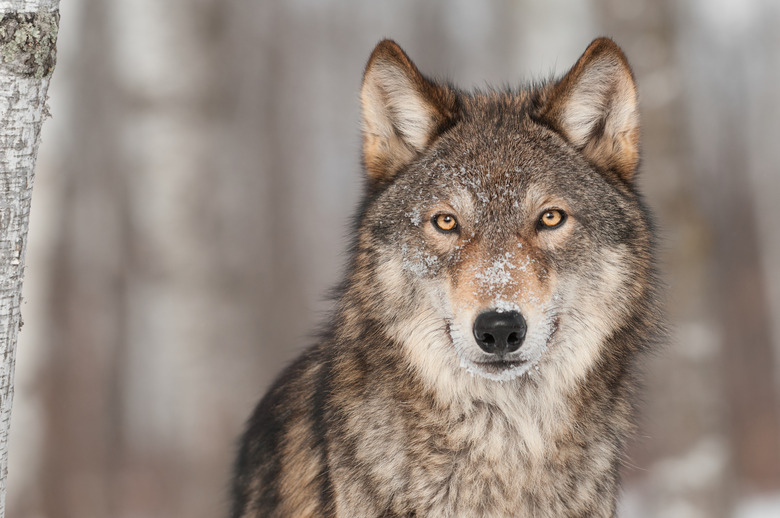Animals That Inhabit The Polar Tundra
The polar or Arctic tundra consists of that treeless (or mostly treeless) biome of the Northern Hemisphere that lies north of the boreal forest, or taiga. These high-latitude "barrens" of ground-hugging grasses, sedges, herbs, stunted shrubs, mosses and lichens endure a severe climate defined by a long, cold, dark winter and a short summer of extended daylight.
Given these harsh constraints, biological diversity isn't very high, but there's still a remarkable lineup of animals calling the Arctic tundra home – whether as seasonal visitors or full-time residents.
Mammals of the Tundra, Large and Small
Mammals of the Tundra, Large and Small
Despite the landscape's apparent bleakness, tundra animals count among them some impressively big mammals, humans included. Caribou – more typically called reindeer in the Old World – inhabit both the North American and Eurasian tundras, with many mainland populations migrating between tundra calving grounds and wintering range in the boreal forest.
Muskoxen, which were prehistorically found on both continents but survived the post-Pleistocene extinctions only in North America, are the biggest native grazers of the tundra; bulls may weigh 800 pounds.
A number of carnivores inhabit the tundra. Polar bears seasonally use coastal tundra, including to den, but they spend much of the year hunting seals on the sea ice offshore. Barren-ground grizzly bears use tundra habitat in Arctic Canada and Alaska.
Various subspecies of gray wolf – including the tundra wolf of Eurasia and the Greenland and Arctic wolves of North America – serve as important top predators of the circumpolar region.
The Arctic fox is a smaller hunter found in both Eurasian and North American tundras, boasting one of the lushest coats of any mammal. The Arctic tundra also supports one of the biggest members of the weasel family, the wolverine.
Among a variety of smaller mammals are tundra hares – the Arctic and Alaskan hares of North America and the mountain hare of Eurasia – as well as the burrowing rodents known as lemmings, which serve as a major prey item for both Arctic foxes and snowy owls.
Birds of the Tundra
Birds of the Tundra
Speaking of which, the emblematic bird of the Arctic tundra is probably the snowy owl. This magnificent bird of prey – the males of which are pure white or nearly so – feeds heavily, sometimes exclusively, on lemmings, but they will also hunt waterfowl, seabirds and ptarmigan. While some snowy owls head south in winter – often showing up in the Lower 48 states – others stay on the tundra year-round, or even head offshore to overwinter on the sea ice.
The snowy owl isn't the only great avian hunter of the tundra. It shares the barrens with the equally impressive gyrfalcon, the biggest of all falcons, which nests on outcrops as well as cliffs of tundra mountains or Arctic coastline. The incredibly swift and agile gyrfalcon hunts a wide range of birds, though ptarmigans are usually the most important prey.
Speaking of ptarmigan, they're among the few birds (like the snowy owl) to tough it out on the tundra all winter. These grouse are well-adapted to these high latitudes, boasting feathered feet and a yearly color change from mottled brown in summer to snowy white in winter – the better to camouflage the birds from their numerous predators.
An incredible spectrum of birds, meanwhile, migrates to the tundra in summer to breed, including many different kinds of waterfowl – ducks, geese, loons and others – and shorebirds such as sandpipers, wagtails, plovers and dunlins.
Another wide-ranging tundra bird in both Eurasia and North America is the common raven, an important scavenger as well as an active hunter of eggs and nestling birds.
Other Tundra Animals
Other Tundra Animals
Freshwater fish such as Arctic grayling and Arctic char live and spawn in tundra rivers, some of which also support part of the anadromous (shifting between freshwater and saltwater) life cycle of northern salmon species.
Reptiles and amphibians are essentially absent from the Arctic tundra, though the hardy viviparous lizard occupies its southern fringe in parts of Eurasia.
In terms of sheer numbers, no tundra animals can compete with insects, from midges, mosquitoes and black flies to butterflies and bumblebees, some 20 species of which are known in the Arctic.
Cite This Article
MLA
Shaw, Ethan. "Animals That Inhabit The Polar Tundra" sciencing.com, https://www.sciencing.com/animals-inhabit-polar-tundra-8603075/. 22 November 2019.
APA
Shaw, Ethan. (2019, November 22). Animals That Inhabit The Polar Tundra. sciencing.com. Retrieved from https://www.sciencing.com/animals-inhabit-polar-tundra-8603075/
Chicago
Shaw, Ethan. Animals That Inhabit The Polar Tundra last modified August 30, 2022. https://www.sciencing.com/animals-inhabit-polar-tundra-8603075/
